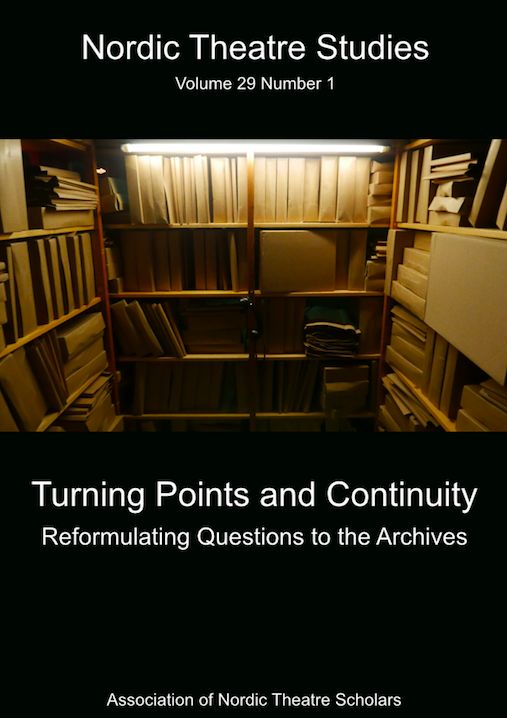Representing Pariah Femininity. Sexuality, gender, and class at the fin-de-siècle
DOI:
https://doi.org/10.7146/nts.v29i1.103308Keywords:
Pariah femininity, sexuality, gender, class, Ellen HartmanAbstract
This article discusses the representation of an actress’s sexuality, femininity, and class at the fin-de-siècle with an emphasis on pariah femininity. The central empirical sources for this study are the correspondence between King Oscar II (1829-1907) and Baroness Henriette Coyet (1859-1941) about the famous actress Ellen Hartman (1860-1945). Tracy C. Davis’s feminist historiographical methodology is put to use in the analysis in combination with Mimi Shipper’s notion pariah femininity. The analysis of the correspondence shows how the actress Ellen Hartman’s femininity was discursively constructed as pariah femininity embodying asexuality, excessive sexuality, and of a degenerate moral. It is argued that Hartman’s specific kind of pariah femininity is based on a perceived threat triggered by her public profession, sexual history and social ambition. Her body was sexualized, her sexuality demonized, and her appearance downgraded to defuse the threatening presence of her profession, femininity, and class. The historical sources also show a change of attitudes toward intersections of femininities and class.
References
Bassnett, Susan. 1989. “Struggling with the Past: Women’s Theatre in Search of a History.” New Theatre Quarterly 5:18, 107-112. DOI: 10.1017/ S0266464X00002992.
Bush-Baily, Gilly. 2007. ”Revolution, legislation and autonomy.” In Maggie. B. Gale & John Stokes, (eds.), The Cambridge Companion to the Actress. Cambridge: University Press, 15-32.
Connell, Raewyn, 2005. Masculinities, 2. ed.. Cambridge: Polity Press.
Davis, Tracy C. 1989. ”Questions for a Feminist Methodology in Theatre History.” In Thomas Postlewait, & Bruce A. McConachie, (eds.), Interpreting the theatrical past: essays in the historiography of performance, 1. ed. Iowa City: Univ. of Iowa Press, 59-81.
Hindson, Catherine, 2007. Female performance practice on the fin-de-siècle popular stages of London and Paris: experiment and advertisement. Manchester: Manchester University Press.
Lang, Maria. 1986. Dödligt drama på Dramaten. Stockholm: Norstedts.
Lindenbaum, Arne. 1952. "Ellen Hartman." Okrönta härskarinnor på Stockholms slott, Stockholm: Fritze, 232-249.
Lyttkens, Alice. 1977. Leva om sitt liv: Minnen från sekelskiftet till 1920. Stockholm: Bonniers.
Löfgren, Lars. 2003. Svensk teater. Stockholm: Natur och kultur.
Nead, Lynda. 1988. Myths of Sexuality: Representation of Women in Victorian Britain. Oxford: Blackwells.
Ohlsson, Hélène. 2016. “Pariafemininitetens återkomst: Diskurser om skådespelerskor runt sekelskiftet 1900.”, Lambda Nordica Queering femininity, volume 21 1-2. 80-106.
Olofsson, Per Rune. 1987. En kung i varje tum. Höganäs: Bra bok.
Schippers, Mimi. 2007. ”Recovering the Feminine Other: Masculinity, Femininity, and Gender Hegemony.” Theory and Society 36:1, 85–102. DOI: 10.1007/ s11186-007-9 022-4.
s.n., Dagen 23.05.1898, KB.
s.n., ”Ellen Hartmans rentrée.” Borås Tidning. 23.04.1892, KB.
s.n., 1934. ”Ellen Hartman Sans-Gêne berättar: En serie artiklar i Vecko-Journalen om gångna tiders stockholmska kultur och teatervärld.” Vecko-Journalen, nr. 14, KB.
Straub, Kristina. 1992. Sexual Suspects: Eighteenth-Century Players and Sexual Ideology. Princeton: Princeton University Press.
Sundberg, Ulf. 2004. Kungliga släktband: kungar, drottningar, frillor och deras barn. Lund: Historiska media.
Tjeder, David. 2003. The power of character: middle-class masculinities, 1800-1900. Univ., Diss. Stockholm Univ.
Torsslow, Stig. 1975. Dramatenaktörernas republik: Dramatiska teatern under associationstiden 1888-1907. Stockholm: Dramatiska teatern.
Wikipedia. Oscar II. Permanent URL: //sv.wikipedia.org/w/index.php?title=Os- car_II&oldid=42120876
Downloads
Published
How to Cite
Issue
Section
License
The copyright belongs to the authors and Nordic Theatre Studies. Users can use, reuse and build upon the material published in the journal but only for non-commercial purposes. Users are allowed to link to the files, download the files, distribute the files on a local network (preferably by links), upload the files to local repositories if their institutions require them to do so, but not republish the files without proper agreements with the journal and the author.

